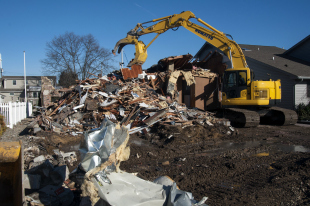The levels of harmful contaminants at Superstorm Sandy cleanup sites in New York and New Jersey have so far not exceeded federal workplace exposure limits, officials said Wednesday, Jan. 9.
The Occupational Safety and Health Administration tested dozens of cleanup sites, measuring worker exposure to toxic substances. The agency fanned out to workplaces and debris sites ranging from beaches to landfills, testing for airborne contaminants and taking samples from debris and storm water.
Some sites showed the presence of contaminants including asbestos, carbon monoxide, lead and silica. Others had increased levels of noise. None, however, were above OSHA’s permissible exposure limits.

Among the jobs being done include debris and sand removal, tree cutting and other cleanup. Other testing came after an employee complained about fumes or air quality.
Results of some tests of the test sites — which include private businesses, parks and roads — are still pending. The agency tested residential demolition sites, but not inside private homes.
“These initial results should not be taken by employers as an “all clear” signal regarding potential exposure to health hazards,” said Robert Kulick, OSHA’s regional administrator in New York, in a statement. “It is important that each employer continually ensure that workers are not overexposed.”
Testing began Nov. 5. The agency said it continues to monitor sites and look for “additional potential contamination left behind in structures as well as in cleanup and recovery process areas where workers may be exposed to additional health hazards.” It will post results on its Hurricane Sandy page.
OSHA representatives have also been talking to employees at worksites about workplace rights and safety.
OSHA did not test places that were previously known to be contaminated for further hazards, but it did check workers for exposure to existing toxins at some of those sites. If a spill happened inside a business that handles hazardous materials, such as a refinery that had an oil spill, it is up to the employer to clean it, assess employee exposure, provide protective equipment or deem the site safe to return to work.
Lenore Uddyback-Fortson, a spokeswoman for the U.S. Department of Labor, said OSHA tested for toxic material “based on what substances were in the area before the storm” and contaminants moved by floodwaters. Other things, including carbon monoxide and noise, occurred because of the cleanup. Some sites were chosen based on the location of floodwaters or proximity to hazardous waste.
However, Uddyback-Fortson said it is not the agency’s “intent or mission to sample every site,” and employers are ultimately responsible for detecting dangers.
Paul J. Lioy, a professor and vice chair of the Department of Environmental Medicine at UMDNJ-Robert Wood Johnson Medical School and expert on toxic exposure, said storms like Sandy can dilute chemicals, but they can also push hazards around. It is no surprise that the results are not all in, he said, because testing takes time.
It is hard to know what toxins the storm could have washed in.
“We have no idea what’s in the soil that’s washed up from sediment that’s coming through flooding or through the groundwater, but they’re testing the right things,” Lioy said. “You test for metals and you test for some organics, you test for highly toxic stuff.”
Topics Workers' Compensation
Was this article valuable?
Here are more articles you may enjoy.


 Door of Swiss Bar Where 40 Died in Fire Was Locked, Says RTS
Door of Swiss Bar Where 40 Died in Fire Was Locked, Says RTS  Allstate Can Proceed With Recovery in Texas RICO Case: Fifth Circuit
Allstate Can Proceed With Recovery in Texas RICO Case: Fifth Circuit  SIAA Announces Strategic Partnership With Progressive
SIAA Announces Strategic Partnership With Progressive  Experian: AI Agents Could Overtake Human Error as Major Cause of Data Breaches
Experian: AI Agents Could Overtake Human Error as Major Cause of Data Breaches 

